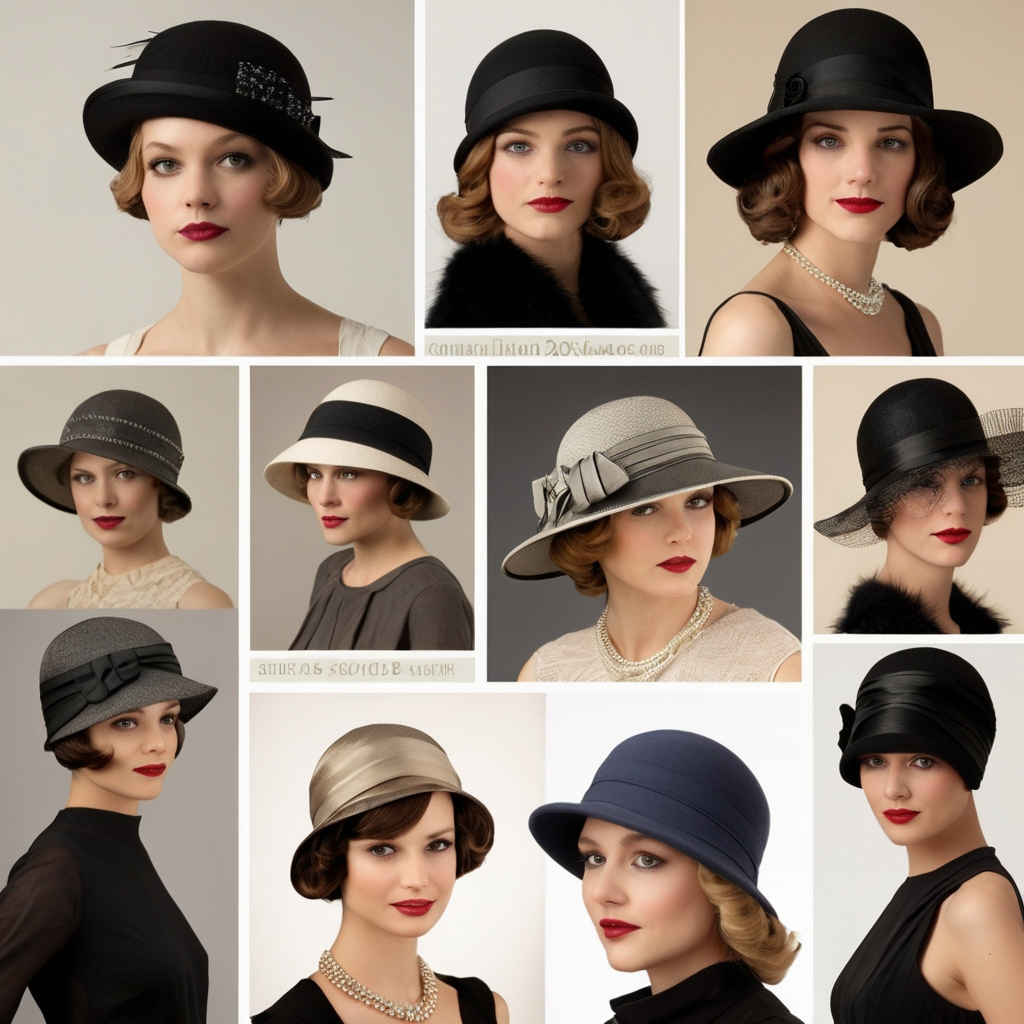Introduction:
The 1920s was a decade defined by experimentation, liberation, and style. Famously known as the Roaring Twenties, this period marked major cultural, fashion, and millinery transformations. Hats emerged as both practical and stylish accessories, with their designs mirroring the era’s evolving social landscape. This post takes a closer look at the enchanting world of 1920s hats, their evolution, cultural significance, and enduring appeal.
By the end of this article, you’ll develop a deeper appreciation for the elegance and innovation of 1920s millinery and understand why these hats remain icons of style today.
The Rise of the Cloche Hat
Among the most iconic hat styles of the 1920s, the cloche hat reigned supreme. Its name—derived from the French word for “bell”—aptly described its unique silhouette, with a deep, close-fitting crown and subtly flared brim that elegantly framed the face.
Although the cloche is often synonymous with the 1920s, its origins date back earlier. Close-fitting hats with deep crowns first surfaced as early as 1908, but this style gained significant popularity during the post-World War I years. By 1923, the cloche had become a cornerstone of women’s fashion.
The appeal of cloche hat was closely tied to the decade’s hairstyle trends. The 1920s introduced a wave of short hairstyles that paired perfectly with the sleek, helmet-like cloche hat. Women shifted from the classic bob, similar to the pageboy cut, to the sharply tapered shingle style, and by 1926–1927, many adopted the daring and boyish Eton crop. The cloche framed these cuts beautifully, enhancing their angular silhouettes while maintaining an understated chicness.
What Made the Cloche Hat Iconic?
The simplicity of the cloche belied its intricate craftsmanship. Early mass production meant that fundamental shaping and blocking techniques efficiently produced these hats. However, high-end cloches showcased remarkable creativity. Designers embraced subtle complexities in construction, such as zigzag or jigsaw patterns and intricate appliqué work. Decorative elements were restrained yet impactful, often placed on one side for asymmetry. Feathers, beads, or scarves flowing to one side became signature adornments, offering an elegant twist to this minimalist design.
The cloche’s adaptability played a key role in its widespread appeal. Casual brimmed felts paired seamlessly with relaxed, sporty outfits for daytime activities like attending sporting events, whereas narrow cloches lent sophistication to eveningwear.
Additionally, cloches drew inspiration from various global influences. Milliners of the 1920s were known to experiment, incorporating Egyptian, Chinese, Japanese, and Russian design elements into their creations. From exotic patterns to decorative accents, the eclectic inspirations added a fresh, international flair to the traditional cloche.
Beyond the Cloche 1920s Hat
Although the cloche hat clearly defined women’s fashion in the 1920s, men’s headwear and other women’s styles reflected equally fascinating era trends.
Hats for the Sophisticated Gentleman
The 1920s offered various choices for men, with hats as vital accessories to indicate social status. Two notable styles emerged as icons of the decade.
- The Boater
This light and structured straw hat, often trimmed with a ribbon band, was particularly appealing among former schoolboys. Over time, the boater transitioned into one of the era’s unmistakable summer staples. It could be found atop the heads of gentlemen attending garden parties, boating events, and even strolls along promenades.
- The Gangster-Style Fedora
More flamboyant and customizable than bowlers or top hats, fedoras gained popularity among more daring individuals of the time. Figures like gangsters and bank robbers famously adopted this hat, associating it with an edgy yet stylish reputation.
Even today, these designs resonate with vintage fashion enthusiasts due to their timeless silhouettes and association with the suave aesthetic of the 1920s gentry.
The Flamboyance of Women’s Brimmed Felt Hats
While minimalist cloches remained the dominant style, wide-brimmed felt hats also gained popularity, particularly in the decade’s later years.
4o min. These hats exuded a casual elegance and paired well with laid-back attire. Bold brims embellished with ribbons or floral motifs added an air of femininity to these designs.
Similar to the cloche, brimmed felt hats embraced artistic diversity. Milliners drew on international cultures, infusing their designs with unique prints, patterns, and vibrant color palettes. These designs celebrated individuality and offered a refreshing alternative to the subtler cloche.
The Cultural Significance of 1920s Hats
The popularity of 1920s hats reflects more than just a fashion trend; it underscores the cultural and societal shifts that defined the era. The Roaring Twenties marked an exhilarating period of liberation, especially for women. It saw the rise of flapper culture, the broadening of women’s rights, and a rejection of traditional conservatism. Hats came to represent this new era of freedom of expression.
For men, hats continued to serve as symbols of status and refinement. Whether worn to casual sporting events or high-profile gatherings, hats reinforced the refined image integral to male fashion.
Reliving the Elegance Today
1920s hats continue to captivate fashion enthusiasts worldwide despite the passing of a century. From Hollywood films to modern runway collections, iconic styles from this era are often reimagined to suit contemporary sensibilities.
For many, wearing a cloche, fedora, or boater hat isn’t just about nostalgia; it’s about connecting to the spirit of innovation and elegance that defined one of the most exciting decades in history.
FAQs About 1920s Hats
Q1. Were cloche hats only popular in the 1920s?
A1. No, cloche hats originated earlier (around 1908) and enjoyed varying popularity in later decades. However, the 1920s cemented their status as cultural fashion icons.
Q2. What materials were commonly used for 1920s hats?
A2. Hats of that era were made using felt, straw, and wool. High-quality cloches often featured intricate appliqué work with feathers, beads, or ribbons.
Q3. Why were 1920s hats so diverse in design?
A3. The global cultural exchange following World War I influenced milliners to incorporate design elements from Egypt, China, Japan, and more into their work, leading to the rich diversity in styles.
Q4. Can I wear 1920s-style hats today?
A4. Absolutely! Vintage-style hats are widely available and can add a touch of sophistication and flair to modern outfits.
